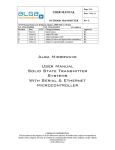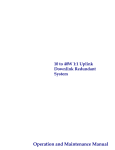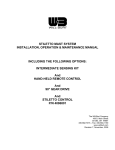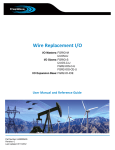Download Alga Microwave User Manual For C and Ku Band Solid State
Transcript
Page: Title ALGA USER MANUAL Date: 15-Nov-07 Microwave OUTDOOR TRANSMITTER 2109 St-Regis, Dollard des Ormeaux, Quebec, CANADA H9B 2M9 Tel. (514) 683-6113 FAX (514) 683-3312 www.alga.ca Revision Date ECN Change Summary 0A 21-May-05 Initial release 0B 27-Jan-06 Updated release 0C 17-May-06 Updated release 0D 28-Aug-06 Updated release 0E 15-Nov-07 Adjusted some terms, new updates Rev: 0E Approval AY AY AY AY AY Alga Microwave User Manual For C and Ku Band Solid State Transmitter Systems COMPANY CONFIDENTIAL This document is the property of ALGA Microwave and may be neither used, copied, nor reproduced outside of the company. Nor may its contents be communicated outside of the company, except with the written permission of ALGA Microwave ALGA Microwave Table of Contents Table of Contents ..............................................................................................2 Outdoor Solid State Transmitter System User Manual......................................3 Description.....................................................................................................3 Equipment Supplied.......................................................................................3 General Information .......................................................................................4 Safety Considerations ................................................................................4 High Voltage Hazards ................................................................................4 RF Transmission Hazards..........................................................................4 Inspection...................................................................................................4 Return of Equipment ..................................................................................5 Ports and Interfaces.......................................................................................6 Prime Power Connection............................................................................6 RF Input .....................................................................................................6 RF Output...................................................................................................6 M & C Connector........................................................................................7 Redundancy Port .......................................................................................7 Master / Slave Selector Switch...................................................................7 Airflow ........................................................................................................8 Monitors and Controls....................................................................................9 Temperature Monitor..................................................................................9 RF Output Power Monitor...........................................................................9 Summary Alarm .......................................................................................10 HPA Mute Control ....................................................................................10 Ground (GND)..........................................................................................10 LO Locked/Unlocked Monitor ...................................................................10 RS-232 / RS-485......................................................................................10 Monitor and Control Software...................................................................10 Outdoor Transmitter Quick Start Guide .......................................................14 General Maintenance ..................................................................................15 Basic Cleanliness.....................................................................................15 Internal Fuse ............................................................................................15 Fan Replacement.....................................................................................15 Theory of Operation.....................................................................................16 AC / DC Converter ...................................................................................16 DC / DC Converter ...................................................................................16 Cooling System ........................................................................................16 Block Upconverter....................................................................................16 Booster Amplifier......................................................................................16 Microcontroller..........................................................................................17 Attenuator Module....................................................................................17 Dual Transfer Switch ................................................................................17 Appendix A ..................................................................................................18 Installation Notes for Redundant System .................................................18 Outdoor Transmitter User Manual R0E.doc 2 ALGA Microwave Outdoor Solid State Transmitter System User Manual This section provides the general information for the Alga Microwave line of Outdoor Solid State Transmitters. The Outdoor Solid State Transmitter has been designed and manufactured to be an extremely robust and reliable. It is well suited for harsh outdoor environments. Description Please refer to Appendix A for the appropriate product data sheet and specifications. The Outdoor Transmitter is a one-piece integrated amplifier system. It includes the AC / DC Power Supply, microwave Booster Amplifier Module, Block Upconverter (BUC), microcontroller based monitor and control circuitry, and an efficient thermal management system. The reduced size and weight of this system allow it to be used in a wide variety of installations; many of which historically precluded the use of solid state units. This system is ideal for mounting on the boom of small antennas or anywhere that size and weight are a major concern. Features include: • Compact size • Light weight • Auto-Sensing Power Supply • Output Power Detection • Optional Internal 1:1 Redundant Capability • Optional Serial (RS-232 / RS-485) or Parallel Monitor & Control Circuitry • Optional Windows Monitor & Control Software • Optional gain control (on selected configurations) Equipment Supplied The following equipment is supplied with each unit: • The Outdoor Transmitter Assembly • Prime Power Mating Connector, MS3106E16-10S • M & C Mating Connector, MS3106E20-29P (where applicable) • CD with Alga Microwave Monitor & Control Software (where applicable) Outdoor Transmitter User Manual R0E.doc 3 ALGA Microwave General Information Safety Considerations Potential safety hazards exist unless proper precautions are observed when working with this unit. To ensure safe operation, the user must follow the information, cautions, and warnings provided in this manual as well as the warning labels placed on the unit itself. High Voltage Hazards Only qualified service personnel should service the internal electronic circuitry of the Outdoor Transmitter. High DC voltages (400 VDC) are present in the power supply section of the amplifier. Care must be taken when working with devices that operate at this high voltage levels. It is recommended to never work on the unit or supply prime AC power to the unit while the cover is removed. RF Transmission Hazards RF transmissions at high power levels may cause eyesight damage and skin burns. Prolonged exposure to high levels of RF energy has been linked to a variety of health issues. Please use the following precautions with high levels of RF power. • Always terminate the RF input and output connector prior to applying prime AC input power. • Never look directly into the RF output waveguide. • Maintain a suitable distance from the source of the transmission such that the power density is below recommended guidelines in ANSI/IEEE C95.1. The power density specified in ANSI/IEEE C95.1-1992 is 10 mW/cm². These requirements adhere to OSHA Standard 1910.97. • When a safe distance is not practical, RF shielding should be used to achieve the recommended power density levels. Inspection When the unit is received, an initial inspection should be completed. First ensure that the shipping container is not damaged. If it is, have a representative from the shipping company present when the container is opened. Perform a visual inspection of the Outdoor Amplifier to make sure that all items on the packing list are enclosed. If any damage has occurred or if items are missing, contact: Alga Microwave Inc. 2109 St-Regis Dollard des Ormeaux, Quebec H9B 2M9 Canada Phone: 514-683-6113 Fax: 514-683-3312 Outdoor Transmitter User Manual R0E.doc 4 ALGA Microwave Return of Equipment When returning items back to Alga Microwave for replacement or repair, please prepare the following information: • • A written description of the problem encountered. The part number and serial number of the unit in question. Once this information is ready, contact Alga Microwave for a Return Material Authorization (RMA) number and shipping instructions. Outdoor Transmitter User Manual R0E.doc 5 ALGA Microwave Ports and Interfaces Prime Power Connection The Prime Power Connector is the point where the unit receives input power. Two different configurations are possible: AC input or DC input (please review the unit’s accompanying Bench Test Record to determine which type of input is used). The AC input can operate over a range of 90 - 270 VAC, at 47 - 63 Hz. This connector is a 3 pin circular connector, MS3102R16-10P. The mating connector, MS3106E16-10S, is supplied. Units with higher output power levels (> 50 W for Ku Band and > 100 W for C Band) should be powered only from a 180 - 270 VAC source. This will keep AC line currents to a safe operating level. In some cases, the unit may only be specified to operate at higher input voltage levels – please consult the accompanying Bench Test Record for this information. The DC input operates at 48 VDC and uses the same 3 pin connector as the AC input models. Also, the same mating connector as stated above is supplied. Whether AC or DC input, when wiring up the mating connector, carefully follow the pin descriptions noted in the accompanying Bench Test Record. Incorrect connections can seriously damage the unit. Please contact the factory if there are any questions regarding these input connections. RF Input The RF Input connector is a type N female connector (type F female is an option). The input frequency is in the L Band. Nominal RF input levels are approximately -28 dBm depending on the output power level and the system gain of the unit. The maximum input level should be limited to +10 dBm to avoid damaging the unit. The input connector must also receive a 10 MHz reference signal, which is used to frequency lock the internal Block Upconverter. Absence of this signal will place the unit into a muted condition and a Lock Monitor alarm will be present. The nominal input level of the 10 MHz reference signal is 0 dBm (+/- 5 dB). RF Output The RF Output is brought out through coaxial or waveguide in the Outdoor Transmitters. The Ku Band Transmitters have a WR-75 Grooved Flange while the C Band Transmitters have CPR style grooved flange (CPR-137G). An Outdoor Transmitter User Manual R0E.doc 6 ALGA Microwave isolator is provided at the output flange with a termination capable of handling full reflected output power. The Transmitter’s output is taken from the coaxial or waveguide RF Out port. Caution should be observed here to make sure that the antenna or a suitable termination is connected to this port before operating the Transmitter. The Transmitter is protected against full reflection but dangerous levels of microwave energy can be present at this port. Never look directly into the RF output waveguide. M & C Connector The Monitor and Control (M & C) connector is the primary input for controlling the Transmitter and monitoring fault conditions. It is a 17 pin circular connector, MS3102R20-29S. It requires a mating connector, MS3106E20-29P, which is supplied with the unit. See the next section for a more detailed explanation of the M & C functions. Redundancy Port Present on Redundant configured units only. The interface connector is used to connect between two Transmitters and a waveguide/coaxial dual switch when used in a 1:1 redundant system. It is a 10 pin circular connector MS3102R18-1S. It requires a mating connector MS3106F18-1P. A Y-link cable with the required mating connector is provided with a Redundant System. A Redundant configured unit may be operated in stand-alone mode, and behaves in a similar way to a normal Microcontroller equipped unit. If this is done, it is important to cover the Redundancy Port to protect it from the external environment, since there are live voltages present on this interface. Never connect anything accept for the supplied Y-link cable to this interface port. Master / Slave Selector Switch Present on Redundant configured units only. This selector switch is used to configure the unit as Master or Slave. A Redundant System is composed of precisely one Master and one Slave. There may be a protective bracket around the switch that prevents accidental toggling of the switch. On some units, the Master/Slave assignment is hardwired inside the unit. The Master/Slave assignment is detected when powering up the Redundant System. Note: Always ensure that when operating the Redundant System, that one unit is set as Master, and the other is set as Slave. If they are set as Master/Master or Slave/Slave, the Redundant System will not switch properly. Power down the unit to correct the settings and try again if this happens. Also, when replacing Outdoor Transmitter User Manual R0E.doc 7 ALGA Microwave one of the units for servicing, always check that the replacement unit has the same Master/Slave setting as the unit being removed. Airflow The air intake and exhaust are both located on the bottom side of the Transmitter. The intake is brought through a fan while the exhaust is along the rows of heat-sink fins. A minimum clearance of 12 inches (305 mm) should be maintained between the air intake of the Outdoor Transmitter and exhaust during operation. This will ensure that there is no forced re-circulation of airflow from exhaust to intake. Lower output power units are not equipped with a fan, but the same clearance stated above must be kept around the unit for proper operation. Outdoor Transmitter User Manual R0E.doc 8 ALGA Microwave Monitors and Controls Monitor signals and Control lines are present on the M & C Connector when this option is installed. With a Microcontroller equipped system, all Monitors and Controls can also be accessed remotely by RS-232 / RS-485.to a Windows based PC; and other Alarms become available as well. Units equipped with a Redundancy option have a Microcontroller M & C installed by default. The full M & C Connector pinout is listed here for convenience. However, always check the Test Bench Record supplied with the unit to view which interfaces have been installed on your unit, or to see if it has had any custom modifications. M & C Connector Pin A B C D E F G H J K L M Description Signal GND Temperature Monitor RF Output Power Monitor Summary Alarm HPA Mute Control RS-485 RS-485 + RS-232 Rx RS-232 Tx RS-232 GND LO Monitor GND To connect the RS-232 interface to a standard PC 9 pin D-sub serial port, make the following connections: M & C Connector Pin H J K DB-9 Pin 3 2 5 Temperature Monitor The temperature of the unit baseplate is monitored by a voltage analogous to temperature. The output is 3.0 V at 27 ºC with a slope of 10 mV / ºC. RF Output Power Monitor The output power of the unit is monitored by a voltage analogous to the output power level. The voltage is restricted to in between 0 V to 5 V. This detected voltage is useful over a 20 dB range of output power. Outdoor Transmitter User Manual R0E.doc 9 ALGA Microwave Summary Alarm The Summary Alarm “ORs” together four different conditions – an over temperature alarm, a user mute enable, an internal power supply fault, and a LO lock monitor alarm. If an over temperature condition occurs, the unit will be placed into a muted state and the Summary Alarm will go low (0 V). Also, if the unit is muted through the Mute Input, the Summary Alarm will also show an alarm condition (low). HPA Mute Control Shorting this line to Ground or applying 0 V to this line will disable the Booster Amplifier module. Leaving it open or applying 5 V will keep the unit enabled. Ground (GND) This pin is connected to the chassis, which also represents the main Ground of the unit. LO Locked/Unlocked Monitor This alarm indicates the PLL lock status of the internal BUC module. A logic low (0 V) indicates no alarm (Local Oscillator locked), while a high (5 V) indicates a problem (Local Oscillator unlocked). RS-232 / RS-485 Available with Microcontroller equipped systems. This serial link is normally used to communicate with a remote PC running Alga Microwave Monitor and Control Software. This enables a simple way to view / control the Monitors and Controls listed above, and also enables the functions listed below. Normally, either RS-232 or RS-485 is available at any one time (both interfaces cannot be used simultaneously). Communication links using RS-232 are typically good up to 30 ft. (9 m) in length. Installations exceeding this length should use the RS-485, which will allow serial control up to 4000 ft. (1200 m). Monitor and Control Software Alga Microwave Monitor and Control Software is provided on CD for units equipped with an onboard Microcontroller system. A Windows based PC uses this software to remotely monitor and control the transmitter through its serial port. The software interface is split in two, indicating “Master Unit” and “Slave Unit”. Both sections are active for redundant configurations, while only one of the sections is used for stand-alone operation. Various Monitors and Alarms are displayed along the left hand side of the interface. If a problem has been detected, it will be displayed in red, and the Transmitter will be placed into a muted state. Outdoor Transmitter User Manual R0E.doc 10 ALGA Microwave Installation Instructions System Requirements: • PC running Windows 98, Me, 2000, or XP (NT 4.0 with Service Pack 6a) • Display resolution of 800 x 600 or greater • Free serial port (RS-232 or RS-485) • Microsoft .NET Framework. Compatibility under Windows Vista has not been tested. The Monitor and Control Software is located inside the Monitor854 folder on the CD. Copy this folder to your preferred location on your PC. The Monitor854 program requires Microsoft .NET framework (included). If this is not installed, please run "dotnetfx.exe" under the Microsoft .NET Redistributable folder on the CD. Start the software by running “monitor854.exe”. Status Display This indicator shows the general status of the transmitter – if everything is good, or if an error condition has occurred, or if the unit has been manually disabled by mute control. Also, the operating status of a Master/Slave redundant pair is reflected. Booster Temperature Display Using the Alga Microwave Monitor and Control Software, a thermometer display with a numeric readout of the baseplate temperature of the unit in degrees Celsius is shown. The baseplate temperature typically experiences a 20 to 30 degree rise above ambient on the highest power Outdoor Transmitters and 15 to 20 degree rise on lower power units. This display corresponds with the Temperature Monitor outlined in the analog M&C section above. Output Power Display A numeric readout of the output power level is displayed in units of dBm. The indicator is calibrated at the factory using the middle frequency of the transmitter, and has approximately a 20 dB dynamic range. When this range is exceeded, the readout shows “Low” or “High” depending on which particular limit has been reached. This display is derived from the RF Output Power Monitor signal outlined above. Overheated Alarm This alarm indicates when the unit’s baseplate rises above about 85 ºC, which is an overheated condition. The unit will automatically enter into a muted state. This function has approximately a 20 ºC hysteresis window which will allow the Outdoor Transmitter User Manual R0E.doc 11 ALGA Microwave transmitter to re-enable itself when the temperature is reduced by 20 ºC at the baseplate. PS Voltages Monitor The output voltage levels of the Power Supply are monitored and this alarm indicates when any of them fall below a preset level. Three voltages are monitored: +12 V feeding the Booster Amplifier, +24 V going to the BUC, and –5 V from the bias assemblies attached to the Booster Amplifier. The unit will enter a muted state when this alarm is active. Manual Control Enable/Disable and Mute Input A manual mute control can be accessed from the Enable/Disable button of the software. Note that this control is independent of the HPA Mute Control (labeled as Mute Input in the GUI) outlined above and is accessed from the hardware M & C port. Also note that the hardware HPA Mute Control has priority over the mute status – a transmitter placed into a muted status by the hardware HPA Mute Control line cannot be brought out of muted status by the software Enable/Disable button. The status of the Mute Input line is monitored and displayed by the software. For systems set up for 1:1 Redundant operation, this control is also used for manually selecting the Active unit in a redundant pair. PLL Status Display The PLL Status reports the lock condition of the BUC module, and corresponds with the LO Locked/Unlocked Monitor described above. If the transmitter loses lock, the transmitter is disabled and an alarm is indicated. For redundant configurations, make note of the Reset PLL Status Button listed below. Mate Status In redundant configurations, the Mate Status indicates the mute condition of its mate. That is, the Master display shows the Slave condition, and the Slave display shows the Master condition. Reset PLL Status Button Used only in redundant configurations. If a LO Monitor alarm occurs, PLL Status will store the alarm until Reset PLL Status is pushed, or power is cycled to the unit. Attenuator Control System conversion gain can be changed here provided an attenuator module has been installed. The range of control is from 0 dB (no attenuation applied) to 20 dB (20 dB of gain reduction) in 0.5 dB steps. The value may be stepped up or down, or entered directly with the keyboard by highlighting the entry field. Note Outdoor Transmitter User Manual R0E.doc 12 ALGA Microwave that this control is dependent on an installed hardware option. installed, this control will not have any effect. If it is not Temperature Compensation Tighter temperature compensation response is also possible with the attenuator module installed. There is no user control here, and the unit must have the requisite hardware option installed, and be calibrated at the factory for this function to be active. Communication Status The communication status between the software and the transmitter is reflected here. If there is a problem here, double-check all serial port connections and ensure the correct Com port is selected (the software uses the Select Port menu item). Menu Items Under the File menu item, there is a set of calibration routines exposed to the user. These are intended for factory use only. No support will be provided if any of these settings are adjusted. Under the Select Port menu item, your appropriate Com port is selected for serial communication to the Transmitter. Outdoor Transmitter User Manual R0E.doc 13 ALGA Microwave Outdoor Transmitter Quick Start Guide • • • • • • • Connect the L Band / 10 MHz Reference to the labeled port. Nominal IF input levels are approximately -28 dBm depending on the output power level of the unit. The 10 MHz Reference must be in the range of –5 dBm to +5 dBm. Note that the transmitter will be in a mute state with the Reference signal absent. The transmitter’s output is taken from the waveguide port (RF Out). Caution should be observed here to make sure that the antenna or a suitable termination is connected to this port before operating the transmitter. Ensure there is proper clearance around the unit. Connect AC Input power to the connector. The unit will be enabled almost immediately, provided it is not forced into a mute state. Optional - Connect the M & C interface to an available COM port on your computer and/or to your analog based monitoring and control equipment. Optional - Install the Windows based Monitor and Control Program from the supplied CD. Optional - Run the Alga Microwave Monitor and Control Program. Review Appendix A for additional information on setting up a Redundant System. Outdoor Transmitter User Manual R0E.doc 14 ALGA Microwave General Maintenance With proper care and maintenance, your transmitter will provide many years of reliable service. Please follow these maintenance guidelines so that your equipment will provide you with the maximum amount of trouble-free service. Basic Cleanliness The exterior chassis of the transmitter acts as a large heatsink that must dissipate at least a few hundred Watts. Excessive dirt, dust, debris, and sand accumulated on the chassis surface will impede its ability to dissipate heat, and will result in higher internal temperatures, potentially shortening the transmitter’s lifespan. Periodically inspect the chassis for excessive dirt, and remove as necessary. A brush combined with compressed air is the safest way to clean the unit. Also, inspect the fan assembly for any dirt or debris that also might impede airflow. Internal Fuse The internal power supply is protected by a fuse to prevent excessive input current consumption. Contact the factory if you suspect the internal fuse has tripped, and instructions will be sent on how it can be replaced. Fan Replacement Normally the fan on the unit operates continuously when input power is connected to the unit. If the fan stops turning, and the transmitter still provides an output signal when it is cool, it is time to replace the fan. Immediately remove power to the unit the prevent damage by overheating. Contact the factory to order the correct replacement fan for your particular model. The fan is encased in a shroud to direct airflow to the chassis heatsink fins. First remove the shroud from the main chassis using the screws at each side of the chassis. The fan and shroud assembly will be connected by wires to the main chassis. Disconnect the wire connection by pulling apart the inline (wire to wire) connector. Next, remove the screws holding the fan to the shroud and fan grille. Remove the fan, and install the replacement fan in reverse order as described above. Outdoor Transmitter User Manual R0E.doc 15 ALGA Microwave Theory of Operation AC / DC Converter The prime AC input power is delivered to a converter module that produces 300 VDC. This module is an auto-sensing front end that has proven reliability and allows the amplifier system to operate over a wide variety of input power conditions encountered around the world. DC / DC Converter The DC/DC converter module is a switched mode power supply that converts the 300 VDC to 12 VDC. This 12 VDC is the primary high current, DC voltage source that operates the booster amplifier module. A secondary module converts the 300 VDC to 24 VDC. This source powers the Block Upconverter and the Cooling System. Units with input AC power use the above AC / DC and DC / DC topology. Units with DC input use a single DC / DC converter stage to convert from the input supply voltage to the system’s required 12 VDC and 24 VDC. Cooling System The Outdoor Transmitter’s cooling system represents a landmark in microwave telecommunication amplifiers. It is a unique system of heat sinks that have been computer optimized to provide extremely efficient cooling of all of the system’s functional blocks. This high efficiency cooling system is primarily responsible for the small overall package size and reduced weight of the unit. The Cooling System is based on a forced convection technique in which both system fans provide the air intake while the exhaust is brought out around the outer perimeter of the fans. The fan is up to 300 CFM rated and operate into approximately 0.3 in. H20 back pressure. It is also weather protected for reliability under a variety of conditions. Block Upconverter The Block Upconverter (BUC) takes an L Band input, and through a single frequency translation, converts the signal to the final output frequency (C or Ku Band). The BUC locks onto an input 10 MHz reference signal to provide the final output frequency. The conversion gain for this sub-section is in the neighborhood of 55 dB. Booster Amplifier This module uses GaAs MESFET technology to boost the signal level to its final output power level. A bias assembly connects the +12 V power supply with the FETs, and provides proper bias voltages (including the negative voltage for the FET gates), and voltage sequencing at turn on and turn off. The gain for this section is in the neighborhood of 20 dB. Outdoor Transmitter User Manual R0E.doc 16 ALGA Microwave Microcontroller This section is responsible for serial communications and for processing of the Monitors and Controls. Various alarms are monitored, such as overheating and PLL lock alarms, along with select DC voltages. The microcontroller disables the transmitter when any of these status indicators show a problem. In addition, it is possible for the microcontroller to report output power levels in dBm and control system conversion gain (when appropriate hardware is installed). In Redundant configured units, the Microcontroller is also responsible for system switching behavior. Attenuator Module This is an electrically controlled variable attenuator – an optional component that generally receives control signals from the Microcontroller. It is responsible for both gain control functions and supplemental gain versus temperature compensation. Dual Transfer Switch Supplied only with Redundant Systems. It is a dual switch with a coaxial section and a waveguide section. The coaxial section is used to transfer the input signal to either Master or Slave, and the waveguide section is used to transfer the output signal from either Master or Slave. Port 3 is terminated on both coaxial and waveguide sections, Port 4 connects to the Master, and Port 2 connects to the Slave. Coaxial Port 1 acts as the system input, and Waveguide Port 1 acts as the system output. A manual switch position knob is present, but this should normally never be used when the system is connected and powered up. Outdoor Transmitter User Manual R0E.doc 17 ALGA Microwave Appendix A Installation Notes for Redundant System The redundant system is composed of the following items: 1. 2 outdoor transmitter units, each configurable between Master or Slave (or M / S). Note that older units may be internally hardwired for Master/Slave operation and cannot be changed. 2. 1 waveguide dual switch assembly. 3. 1 redundant port cable assembly (3 connector Y assembly). 4. 2 input cable assemblies. Assemble the transmitter units onto your support bracketing (may not be supplied). Use the toggle switch on the unit to select either Master or Slave operation mode (M or S). The Redundant System must have precisely 1 Master and 1 Slave. Make note of which unit is the Master and which is the Slave. Before making any connections, ensure that all ports and interfaces have all plastic covers or protective films (tape) removed. Using the waveguide dual switch assembly, check the alignment of the RF Out ports on the transmitters, and adjust as necessary. • Waveguide Port 4 of the switch attaches to the RF Out port of the Master. • Waveguide Port 2 of the switch attaches to the RF Out port of the Slave. • Waveguide Port 3 is terminated. • Waveguide Port 1 acts as the redundant system output. Connect the 2 IF input cable assemblies and other coaxial connections: • Coaxial Port 4 of the switch connects to the IF Input port of the Master. • Coaxial Port 2 of the switch connects to the IF Input port of the Slave. • Coaxial Port 3 is terminated. • Coaxial Port 1 acts as the redundant system input. Connect the redundant port cable assembly: • Attach J1 to the Master Redundancy / RF Switch Port. • Attach J2 to the Slave Redundancy / RF Switch Port. • Attach J3 to the waveguide switch (circular connector). When using the serial port interface, it is recommended to only connect to the Master Unit M&C Port. Both Master and Slave unit can be accessed through the software GUI in this way using a single connection. The input to the redundant system is Coaxial Port 1 of the switch, and the output is Waveguide Port 1 of the switch. Outdoor Transmitter User Manual R0E.doc 18





























